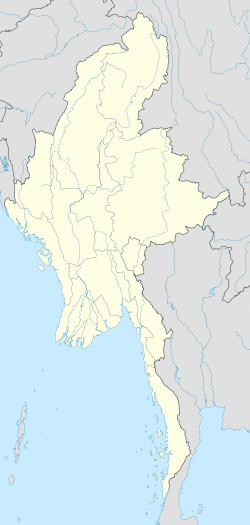Taungdwingyi
တောင်တွင်းကြီး Ponnawaddy | |
|---|---|
Town | |
 Kandawgyi Lake of Taungdwingyi | |
| Nickname: Taungdwin | |
| Coordinates: 20°00′06″N 95°32′46″E / 20.00167°N 95.54611°E | |
| Country | |
| Division | |
| District | Magway District |
| Township | Taungdwingyi Township |
| Elevation | 138 m (453 ft) |
| Population | |
| • Total | 145,909 |
| Demographics | |
| • Ethnicities | chiefly Bamar |
| Time zone | UTC+06:30 (MST) |
| Area Code | 063 |
| Geocode | MMR009004 |
Taungdwingyi (Burmese: တောင်တွင်းကြီး [tàʊɰ̃dwɪ́ɰ̃dʑí]) is a town located in Magway Region, Myanmar.
YouTube Encyclopedic
-
1/3Views:4 1353 47113 691
-
Myanmar - Sugar Cane Train from Pyinmana. December 2018
-
アフリカのタンザニアとザンビアを結ぶ鉄道の旅【後編】
-
2016 ミャンマー旅行記 #8
Transcription
Town scape

The town is divided into ten main quarters. They are Ohndaw Quarter 1, Ohndaw Quarter 2, Taungbyin Quarter 1, Taungbyin Quarter 2, Shwe-oh Quarter 1, Shwe-oh Quarter 2, Maungdaing Quarter 1, Maungdaing Quarter 2, Shwe Kya-in Quarter 1 and Shwe Kya-in Quarter 2. At the center of the town are the Myoma Zay central market, and the Independence Park. The Kandawgyi Lake, which used to be a weir in ancient times, is located on the east side, and is ringed by a number of historic Buddhist monasteries. Zeya Mingala Shweindaung is the most sacred pagoda in the township. The Aung Myin Zeya Rakhine Pagoda located at the western part of the town is the largest pagoda in the township. Once, it was in a state of decay and renovation was finished in 2013.
Economy
Economic of this town is based on agriculture and trading agricultural products. Onion, rice, beans, grains, and sugarcane are grown. Peanut oil is also a major product of the town.
Transportation
Taungdwingyi is connected to Magway (68 km (42 mi)) to the West, Pyay (162 km (101 mi)) to the South and Naypyidaw (68 km (42 mi)) to the East, by means of territorial roads and railways. By the territorial roads, it is 227 km (141 mi) to Mandalay and 365 km (227 mi) to Yangon. The closest major airport is the Magway Airport (MWQ).
History
The Taungdwingyi region is one of the earliest inhabited regions in Myanmar. The Pyu city of Beikthano was founded around 200 BCE.[1] In 1278, a member of the Pagan royalty, Thihapate reestablished Taungdwingyi.[citation needed] In 1480, King Minkhaung II sent Lord Zeya Kyawhtin to administer the town. During the Ava period (1364–1555), the region produced a number of famous poets and writers such as Shin Ohnnyo, Shin Khayma, Shin Uttama and Shin Maha Thilawuntha, Shin Nyeinme and Khingyi Phyaw.[citation needed]
Weather
April is warmest with an average temperature of 39 °C (102 °F) at noon. January is coldest with an average temperature of 14 °C (57 °F) at night. Temperatures drop sharply at night. January is on average the month with most sunshine. The wet season has a rainfall peak around August, the dry season is around the month of March.
Nature
Taungdwingyi has a humid (> 0.65 p/pet) climate. The climate is classified as a tropical monsoon (short dry season, monsoon rains other months), with a subtropical dry forest biozone . The soil in the area is high in nitosols, andosols (nt), soil with deep, clay-enriched lower horizon with shiny ped surfaces.
Gallery
-
Kandawgyi Lake, Taungdwingyi, Myanmar.
See also
References
- ^ Aung-Thwin, Michael (2005). The mists of Rāmañña: The Legend that was Lower Burma (illustrated ed.). Honolulu: University of Hawai'i Press. pp. 18–19. ISBN 9780824828868.




